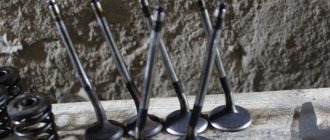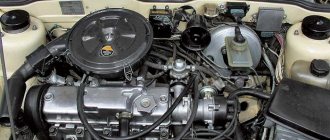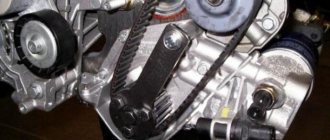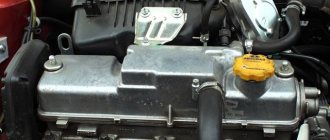Whether the valves on a Grant bend or not depend on the vehicle’s configuration. Drivers of Kalina 2 also encountered the problem of valve damage due to a broken timing belt. However, when buying a Grant, the future owner hopes for modifications to the engine, believing that the problem has now been eliminated and the valves do not bend. We won’t argue, but will answer in order: who was “lucky” to become the owner of a problem car, and how to avoid expensive overhauls.
On which Grant engines do the valves bend when the timing belt breaks?
Current Grant owners claim that not all 8-valve engines are problematic. In particular, the “Standard” package is equipped with a truly high-quality power unit and will not cause serious damage to its future owner.
But “Norma” can make the driver worry, because a broken timing belt will lead to the need for long-term and expensive repairs. The differences between these engines, which are similar at first glance, lie in different equipment, so you need to pay careful attention to the type of unit when buying a car.
An engine marked 11183 (previously 2111) is quite noisy, but if the timing belt breaks, the valves will remain intact and undamaged. But many buyers would like to know whether the Lada Granta engine 11186 bends the valves, and how inevitable such a problem is.
Breakdowns will not occur if the car is inspected and diagnosed in a timely manner. But for unit 11186 (formerly 21114), even periodic checks will not always be a preventative measure.
Features of the 11186 engine are reduced operating noise, low fuel consumption and increased power. But in addition to the advantages, the modified power unit also received some problem areas: a new connecting rod and piston system. Its main difference is the lighter weight achieved as a result of shortening the pistons. As a result, the reduced space did not allow for practical and safe placement of the mechanisms.
Noise level
I switched to this car from the Renault Megane 2. My Renault was equipped with a 1.6-liter engine, a power of 113 horses, and the number of valves was 16.
After it, the Granta engine works like a tractor. Regardless of the car's mileage. Even the engine on the carburetor VAZ-21093 seemed quieter to me.
I specifically compared the noise level on a new Grant with a mileage of 5,000 km and on mine with a mileage of 55,000 km. As it warms up, the sound becomes quieter, but most likely you just get used to it.
Read more about warming up the engine in the article: the need for warming up: myth or fact?
But it is also worth considering that there are no hydraulic compensators, so you will have to adjust the valves. By the way, the engine in the luxury version (98 hp) also rumbles.
Why does the Granta 8 valve bend the valve?
The breakdown procedure itself is also equally important to study. Having understood which areas are most susceptible to damage, the owner will be able to pay more attention to them or seek help from specialists.
After diagnostics, our technicians will perform a full service and help you avoid numerous causes of timing belt failure: jamming of the pump, rollers, camshaft or crankshaft. The process of valve damage itself occurs according to the following scheme:
1. The timing belt breaks.
2. The camshaft stops.
3. The crankshaft continues to rotate (the flywheel transmits rotation).
4. The pistons hit the open valves when the timing belt breaks.
Thus, the valves become bent, and in the future they will need to be completely replaced. You can also find out whether the valves of the Lada Granta 8 valve are bent from specialists working at the service station.
After all, a breakdown does not necessarily affect every owner of a domestic car. Damage occurs in exceptional cases when the motorist does not devote enough time to servicing the car. Therefore, the root cause is insufficiently conscientious operation.
Many craftsmen recommend that immediately after purchasing a Granta, you have it checked at a service station, since even small nicks on the shafts can lead to a rupture of the timing belt.
In some cases, changing the belt to a stronger one helps: the factory component may not meet the required load and operating conditions. The tension force must fully comply with the stated recommendations of the manufacturers. Therefore, self-regulation can only worsen the situation.
You should also contact a specialist if primary signs appear that may indicate a subsequent belt rupture. It could be minor noise from the timing drive. It is this that will indicate possible wear or partial wedge of the rollers or pump.
All these factors are decisive and can lead to the need for expensive repairs, and in extreme cases, to calling a tow truck if the driver was outside the city at the time of the rupture. The owner of the Grant needs to take into account all the considered nuances and solve the slightest problems immediately after they arise.
It is practically impossible to answer this question unambiguously whether the valves bend on the Lada Grant; it all depends on what kind of engine is installed in the car. Motorists are well aware that the Lada Granta is a prototype of the Lada Kalina car, with its very reliable power unit and durable valves that are not subject to mechanical bends. Unfortunately, according to experts, only the Grant “standard” engine valves can safely withstand a broken timing belt.
If we consider the question of whether the valves on a Grant with a “norm” engine bend, unfortunately we must admit that if the timing belt breaks, this eight-valve engine with a lightweight connecting rod-piston mechanism cannot withstand such damage, the pistons will definitely hit the valves, which will inevitably result in they will bend. This happens for the reason that these two seemingly almost identical engines still have some differences. For example, eight-valve standard pistons have special recesses for the valves, as a result of which, if the belt breaks, the valves remain intact.
Grant engines of the “norm” type have not only a lightweight connecting rod and piston group, but also shortened pistons on which it is physically impossible to make valve recesses, so a broken timing belt in engines of this type is fraught with major, expensive repairs, which once again reminds us of the need for constant monitoring the technical condition of the timing drive.
By the way, the engine of the Lada Priora car has exactly the same defects, although due to the fact that the timing belt itself is very wide and extremely durable, breakdowns of this type occur extremely rarely. This usually happens when trying to start the engine from a pusher or by towing, which is strictly prohibited by the car’s operating instructions. In general, no matter what engine is in your car, preventive maintenance and periodic maintenance of the timing drive is necessary; this can protect you from many major troubles associated with the car.
Timing belt. What is it for?
To transmit torque from the crankshaft to the timing system, most modern cars use a drive belt. Car mechanics and drivers call this part a timing belt. This product is made of durable rubber, reinforced with a special fiberglass cord. For better traction, it has teeth that match the size of the notches on the crankshaft and camshaft pulleys.
The belt performs an extremely important function in the operation of the engine, ensuring a smooth cycle of the intake and exhaust mechanism, and removing exhaust gases to the outside. In addition to the engine shafts, the timing belt on the Grant 8 valve also drives the coolant pump, which is called the “pump”. Without a reliable drive, the operation of the power unit is impossible in principle, so each driver needs to carefully monitor the integrity of the part and replace this element within the prescribed time frame.
Modification 11183 (Standard package, 82 hp)
The very first modifications of the Grant car came with a non-lightweight connecting rod and piston group; on such engines the valves do not bend, it all depends on the speed at the moment the belt breaks. These engines were installed on cars and had the designation 11183. The advantage of this engine is its high-torque power; at the bottom it drives like a diesel engine!
In fact, this is a complete copy of the VAZ-2108 engine, only with an increased volume, and the owners of the nines boasted about stories about how the timing belt broke and nothing happened to the engine.
Dynamics
External view of engine 21116
This is not a racing car, but there is enough power for both city driving and highway driving. If we compare it with the 16-valve engine of the Lada Granta, which is installed on the Luxury versions, then it has more torque at the bottom. This means that you can drive in 5th gear at a speed of 40 km/h.
For example, you are driving at 5 speed, the traffic light in front lights up red. You release the gas pedal and the car brakes with the engine. The light turns green and you can continue driving in 5th gear even if the vehicle speed has dropped to 40 km/h.
I was pleasantly surprised by the elasticity of the motor. Considering that I previously owned a Priora, and it has a 98 hp engine, then the engine is 87 hp. I like grants better.
Pulls like a locomotive!
Engine 21116 (87 hp) - the valves bend!
21116 engine bends valve
This engine is installed on the Lada Granta in the “Norma” configuration. And it also bends the valves, unfortunately.
How to check the condition of the timing belt?
To visually check the timing belt, you must remove the timing cover. This is not difficult to do; with 8 valves there is a lot of space under the hood. Remove the cover and begin a visual inspection of the belt. It should be like new, without cracks or rips, without dirt or deposits, and dry.
If the condition of the belt causes concern, then it must be replaced, for more details, see the article: replacing the timing belt on an 8-valve Granta.
How to check the condition of the pump and tension pulley?
To check the condition of the pump, it is necessary to remove the lower half of the timing cover. Next, release the belt tension by loosening the tension roller. Check the functionality of the pump, spin it and see if there is any play. If there is play, then do not delay and change the pump, as it may jam in the near future.
The tension roller is checked for play in the same way.
You should also be alerted to extraneous noises when the engine is running. A sign of imminent failure of the pump and rollers is the sound of “rustling” of these elements.
There have been cases of timing belt breakage and valve bending as a result of a jammed pump and on a mileage of no more than 20,000 km.
The first VAZ 2110 cars were produced with an 8-valve engine with a volume of 1.5 liters, and later with a 1.6 liter engine. On such units, when the timing belt breaks, the valves do not bend. This is explained by their absence in the piston. In the tenth generation, VAZ 2112 cars appeared with a 16-valve engine and a volume of 1.5 liters. With the release of this model, many car owners began to encounter problems with valve bending on the Priora. The design of the new motor has changed. Due to the 16-valve head, the power of this unit increased from 76 hp. up to 92 hp However, the big problem with such a motor is 21126 valve bending on the Priora. As a result, the car needs major repairs.
The reason why the valves in the Lada Priora were bent is the absence of special piston grooves in the 1.5 engine with 16 valves. Because of this, when the belt breaks, the pistons hit the valves, which bend them. Somewhat later, 16-valve 1.6-liter engines began to be installed on Priora. The design of these engines is practically no different from the previous ones with a volume of 1.5 liters. The main difference is that the new engine has recessed pistons. If the timing belt breaks, the pistons do not meet the valves, and the engine does not bend the valves on the Priora.
The modern engine from AvtoVAZ is presented in the form of a 16-valve unit, which differs from previous analogues in its reliability and safety; bent valves are not typical for it. However, the erroneous opinion of most car enthusiasts is due to the fact that on the updated Priora the engine bends the valves in rare cases. This is explained by the fact that this car is equipped with a 16-valve 1.6-liter engine. Practice has shown that when the timing belt breaks on a Lada, the pistons bend the valve when they meet. Repairing an engine of this type is more expensive than its “12” counterparts. The likelihood of a belt breaking on a Priora is low, since it is almost twice as wide as on “12” engines. When using a defective belt, the question “does the valve bend on a Priora?” will continue to arise.
Valves for motor
Comparing Priora and Kalina engines, auto mechanics claim that owners of a second car face a similar problem. Therefore, it is recommended to regularly monitor the condition of the timing belt. Some car enthusiasts are concerned about whether the valves bend if there is a large layer of carbon on the pistons. Similar breakdowns occur in such motors. Therefore, owners of any type of vehicle should regularly monitor the condition of the timing belt, checking it for cracks, chips, threads and peeling. These signs indicate that the timing belt needs to be changed immediately. Otherwise, the question “does the engine bend the valves on a Priora?” will not be resolved.
Repair of power unit components
As practice shows, nothing lasts forever, and neither do the components of VAZ power units. In this part of the article, we will consider the main malfunctions, as well as methods of elimination and repair.
Timing belt or how not to bend valves
Probably the most interesting question for most motorists is whether the valves on VAZ engines bend? As for the VAZ 11189 engine, we can say with confidence that the valves bend when the timing belt breaks. Of course, valves can bend for other reasons, but the most common is considered to be a broken timing belt.
Another question that car enthusiasts ask in car repair shops and on forums regarding the timing belt is how to prevent valve bending? Everything is very simple - change the timing belt and rollers according to the technical recommendations of the manufacturer. Thus, in the maintenance manuals for engine 11189, the recommended belt replacement period is 45-50 thousand kilometers.
What happens if the valve bends? Everything is very simple - after the valve mechanism is bent, such important elements as the valve guide, valve seat, and oil seals fail. Subsequently, it may happen that this problem affects the piston mechanism. In a word, if the valve bends, then you should hope for the best and expect the worst - that is, a major repair.
How to replace the timing belt and rollers:
- First, you need to remove the protective casing.
- Then, we fix the camshaft, but before that it is necessary to set the timing marks.
- Unscrew the tension roller to release the belt.
- Next, we dismantle the belt itself.
- We change the tension roller.
- Reinstall the timing belt.
Water pump malfunction
The water pump circulates coolant through the engine system. This is done for cooling and to prevent the motor from burning out. The failure of such a unit means that further operation of the power unit is impossible, since overheating will occur and the first thing that will be affected is the cylinder head. To avoid this, you should regularly diagnose the part and replace it on time.
There is nothing difficult about replacing the pump. The procedure is similar to changing the timing belt. After removing the belt, unscrew the bolts securing the water pump and replace it. It should be noted that the coolant must be drained from the system and, after replacement, topped up to the required level.
ECU diagnostics
One of the most common procedures that motorists carry out is diagnosing faults in the electronic engine control unit. This procedure is often performed in a car service center, since not every driver has a special portable diagnostic PC.
Main reasons
Car owners of Lada Priora 21126 are interested in knowing the reasons why the valves on their car bend. Auto mechanics claim that on all modern models of this car, as a result of a broken timing belt, the valve motor bends. The first engines for front-wheel drive VAZ 2110, unlike similar units for rear-wheel drive, had a volume of 1.5 liters. Somewhat later, similar designs with a volume of 1.6 liters appeared. with 8 valves and one camshaft. Some car enthusiasts do not know whether the valves on such engines bend. This process does not occur due to the first elements not meeting the pistons at the dead center. After evolution, new 16-valve units with two camshafts appeared. This made it possible to increase power from 76 hp. up to 92 hp, while the engine size has not changed.
Characteristics of motor 11186
The project of a “people's car” at a budget price for the average LowCost user was seriously hampered by the economic crisis. For the Lada Granta Standard configuration, the technical characteristics of the existing ICE 11183 were sufficient.
However, for the Norma and Lux trim levels, a more powerful internal combustion engine was needed, so the management of AvtoVAZ, not having sufficient funding for the project of a new engine, came out of the situation as follows:
- the existing version 21114 became the basis for the ICE 11186;
- to reduce costs, pistons from the American manufacturer Federal Mogul were replaced with domestic products of a suitable size;
- The manufacturer changed the engine markings, but no more design changes were made.
Piston 11186 is smaller than 11183
Unlike 11183, the piston of the 11186 motor bends the valve when the timing belt breaks, but the performance characteristics are improved:
| Manufacturer | AvtoVAZ |
| Engine brand | 11186 |
| Years of production | 2020 – … |
| Volume | 1598 cm3 (1.6 l) |
| Power | 64.2 kW (87 hp) |
| Torque moment | 140 Nm (at 3800 rpm) |
| Weight | 140 kg |
| Compression ratio | 10,5 |
| Nutrition | injector |
| Motor type | in-line |
| Injection | electronic multipoint |
| Ignition | the electronic unit |
| Number of cylinders | 4 |
| Location of the first cylinder | TVE |
| Number of valves on each cylinder | 4 |
| Cylinder head material | aluminum alloy |
| Intake manifold | plastic receiver, electronic throttle |
| An exhaust manifold | combined with catalyst |
| Camshaft | from 11183 |
| Cylinder block material | cast iron |
| Cylinder diameter | 82 |
| Pistons | lightweight |
| Crankshaft | ductile iron, oil channels |
| Number of main bearings | 5 |
| Piston stroke | 75.6 mm |
| Fuel | AI-95 |
| Environmental standards | Euro 4 |
| Fuel consumption | highway – 5.7 l/100 km mixed cycle 7.3 l/100 km city – 8.5 l/100 km |
| Oil consumption | maximum 1 l/1000 km |
| Engine oil for 11186 | 5W-30 and 10W-30 |
| Engine oil volume | 3.5 l |
| Operating temperature | 95° |
| Motor life | declared 150,000 km actual 300,000 km |
| Adjustment of valves | washers between camshaft cams and tappets |
| Cooling system | forced, antifreeze/antifreeze |
| Coolant quantity | 7.8 l |
| water pump | polymer impeller |
| Candles for 11186 | BPR6ES, A17DVRM |
| Gap between spark plug electrodes | 1.1 mm |
| Timing belt | 163 teeth, pitch 8 mm, belt width 26.7 mm |
| Cylinder operating order | 1-3-4-2 |
| Air filter | Nitto, Knecht, Fram, WIX, Hengst |
| Oil filter | catalog number 90915-10001 replacement 90915-10003, with check valve |
| Flywheel | from 2110, steel crown placed on a cast iron body |
| Flywheel mounting bolts | box MT – M10x1.25 mm, length 26 mm, groove 11 mm box AT – M10x1.25 mm, length 26 mm without groove |
| Valve stem seals | code 90913-02090 inlet light code 90913-02088 exhaust dark |
| Compression | 13 bar |
| XX speed | 650 – 750 min-1 |
| Tightening force of threaded connections | spark plug – 18 Nm flywheel – 62 – 87 Nm clutch bolt – 19 Nm bearing cap – 68 Nm (main) and 53 (rod) cylinder head – three stages 29 Nm, 49 Nm and 90° |
Since the engine does not have hydraulic valve lash compensators, it is practically not important for the user which oil to choose based on the fuel manufacturer. Both domestic and foreign companies are suitable, for example, ZIK, Lukoil, Mobil, Rosneft. On the other hand, relevant information is which oil to pour into the engine based on viscosity:
- for regions of the Russian Federation, the manufacturer recommends all-season oils 10W40, 5W40 and 15W30;
- Synthetic and semi-synthetic lubricants are allowed;
- It is better not to use mineral oil.
To reduce temperature loads on the valves, the engine circuit provides nozzles that inject oil onto their surface. Unlike homemade channels, nozzles fire only when pressure increases, that is, when the lubricant heats up from intense loads. Oil does not enter the crankcase and does not cause increased wear of gaskets in the engine.
Features of recessed pistons
The 10th family of cars was discontinued due to the presence of many technical flaws. The updated family has gone through major changes that affected environmental issues and increased engine power. It should be noted that all 16-valve engines are currently installed not only on Priora, but also on other VAZ models, including Kalina and Granta. However, the engine bends the valves on every such car.
The exception to the fact that if the timing belt breaks, these parts will not meet the pistons are the first eight-valve engines. Modern production of domestic cars does not provide for the use of these units. New eight-valve counterparts with increased power also bend the valves.
Since 2011, Priora had 8 valve engines marked 21114, which did not bend the valves. In recent years, the valves on all produced Lada Priora have been bent, since they have engines with 8 valves marked 21116.
Engine tuning VAZ 11183 (21114)
Let's consider the potential of the 11183 8V engine without replacing the cylinder head with a 16 valve (the 124 engine and its modifications are mentioned in a separate article). The easiest way is to replace the camshaft with an OKB Dinamika 108 or Nuzhdin 10.93, install a split gear, adjust the phases, this will give us about 85-90 liters .With. and a cheerful pick-up at the top. We don’t skimp on the receiver, 54 mm damper and 4-2-1 spider exhaust, this config will perform better than a 16 valve 124 engine, while the cost of modifying the VAZ will be quite reasonable. Refinement of the cylinder head and intake manifold, lightweight T-shaped valves and milling of the cylinder head will allow us to get the most out of it. The estimated power of the VAZ 21114 engine in this case will reach 110-115 hp. Let the engine spin more easily, maybe a light Priorov piston, install it and get 120+ hp.
Compressor for Kalina engine
An alternative method for obtaining such returns is to install a PK-23-1 compressor, and to increase its efficiency we add Vali Nuzhdin 10.42 or 10.63. The well-known video clearly explains everything that is required for a successful project.
Attention MAT (18+)
It is possible to increase power without using a turbine up to 170 hp. and higher, but the service life of the VAZ 11183 engine is noticeably reduced. The right step would be to increase the potential by increasing the efficiency of the engine, namely by installing a 16-valve cylinder head, which, together with the damper, receiver and exhaust on 51 pipes, will give 110-120 hp. without significant loss of resource.
Turbo viburnum engine
The configuration of a turbo engine based on an 8-valve cylinder head is described HERE, the principle is the same.
The problem of a broken timing belt and subsequent damage to the valves was familiar to many Lada Kalina owners. The improved Granta, according to many buyers, has lost this problem.
But still, fears on this score do not go away. Therefore, it is first recommended to find out whether the valves on the 8-valve and 16-valve Grant bend, and which engine models are most reliable for operation.
Cautions and Consequences
Valve bending on a Priora is mainly due to the piston meeting the first parts. If the timing belt breaks, the car owner cannot avoid expensive repairs. In such a situation, auto mechanics recommend:
- regularly check the condition of the belt,
- determine the presence of chips and cracks on the belt,
- check if there are any threads on the belt.
- remove the engine from the car,
- take it apart
- drain and replace oil,
- remove the crankshaft,
- remove the pistons
- remove the connecting rods.
In this case, you will also need to buy a new, lighter piston group. From an official dealer it will cost no more than 2-5 dollars. Some auto mechanics recommend buying a car of another brand, the price of which is practically no different from the cost of the Priora. It could be a KIA RIO or a Chevrolet Aveo. This problem can be solved using an optimized cooling system for the block and cylinder head.
Frequent timing belt breakage is associated with the use of low-quality automotive parts, including the idler pulley. To prevent such a breakdown, Priora car owners install the lower gear on the crankshaft, belt and rollers from the VAZ-2112 on their cars. In this case, the pump and gears on the camshaft do not change. Washers 5 mm thick are placed under the rollers. The presence of a large number of manufacturers of these parts allows you to choose high-quality and reliable products for cars.
The question is interesting and worries many - do the valves on a Lada Granta car bend when the timing belt breaks...
Adjusting thermal clearances in the valve drive of the gas distribution mechanism
We adjust the thermal clearances in the valve drive of the engine gas distribution mechanism in accordance with the maintenance regulations every 30 thousand km. We carry out operations on a cold engine.
Use a Phillips screwdriver to loosen the clamp securing the crankcase gas supply hose to the cylinder head cover...
...and remove the hose from the cover pipe.
Use a Phillips screwdriver to loosen the hose clamp (the main circuit of the crankcase ventilation system)…
...and remove the hose from the cylinder head cover pipe. Similarly, loosen the tightening of the hose clamp (the idle circuit of the crankcase ventilation system)…
...and remove the hose from the cylinder head cover pipe.
Using a 10mm socket, unscrew the three nuts securing the receiver bracket...
...and remove the bracket.
Two studs securing the bracket to the receiver are screwed into cage nuts installed in the grooves of the receiver.
Using a 10mm socket, unscrew the two cap nuts securing the cylinder head cover.
Remove the metal washer from the stud...
...and a rubber bushing. Similarly, remove the cover fastening parts from the other stud.
Remove the cylinder head cover. Remove the front upper timing belt cover (see “Checking the condition and replacing the timing belt”). The procedure for checking and adjusting the clearances in the valve drive mechanism is as follows. We turn the crankshaft by the bolt securing the generator drive pulley clockwise until the installation marks on the camshaft pulley and the rear timing belt cover align (see “Checking the condition and replacing the timing belt”). Then turn the crankshaft clockwise another 40–50° (2.5–3 teeth on the camshaft pulley). In this position of the shafts, we use a set of feeler gauges to check the gaps (between the adjusting washers of the pushers and the cams) at the first...
...and the third camshaft cam. The clearance between the camshaft cams and shims should be 0.20 mm for intake valves and 0.35 mm for exhaust valves. The clearance tolerance for all jaws is ±0.05 mm. The gap is equal to the thickness of the feeler gauge, which fits between the cams and the washer with a slight pinch. If the gap is different from the norm...
...then we install a device for adjusting the valves on the studs of the camshaft bearing housings.
We rotate the pusher so that the slot in its upper part faces forward (along the direction of the car). We insert the “fang” of the device between the cam and the washer (see figure below).
Recessing the valve pusher when replacing the adjusting washer
: 1 – device; 2 – pusher
By pressing down on the lever of the device, we recess the pusher with the “fang”...
...and install a clamp between the edge of the pusher and the camshaft, which holds the pusher in the lower position.
Fixing the valve tappet when replacing the adjusting washer
: 1 – retainer; 2 – adjusting washer Move the device lever to the upper position.
Use tweezers to pry the adjusting washer through the slot and remove it. If you do not have a device for adjusting the valves, you can use two screwdrivers. Using a powerful screwdriver, leaning on the cam, press the pusher down. By inserting the edge of another screwdriver (with a blade width of at least 10 mm) between the edge of the pusher and the camshaft, fix the pusher and remove the adjusting washer with tweezers. We adjust the gap by selecting an adjusting washer with the required thickness.
To do this, use a micrometer to measure the thickness of the removed washer. The thickness of the new adjusting washer is determined by the formula: H = B+ (A–C), mm,
where A
– measured gap;
B
– thickness of the removed washer;
C
– nominal gap;
N
– thickness of the new washer. The thickness of the new washer is marked on its surface with an electrograph. We install the new washer in the pusher with the marking down and remove the lock. Check the gap again. When adjusted correctly, a 0.20 or 0.35 mm feeler gauge should fit into the gap with slight pinching. Consistently turning the crankshaft half a turn, check and, if necessary, adjust the clearances of other valves in the sequence shown in the table:
We assemble the engine in the reverse order. Before installing the cylinder head cover...
...replace its sealing gasket with a new one.
This is interesting: Average fuel consumption per 100 km on Lada Kalina - characteristics
Physics of the process
Let's explain what a timing belt is. The timing belt is a rubber closed belt, with notches on the inside, designed to synchronize the crankshaft and camshaft of the engine. Used when using a belt drive.
When the timing belt breaks, the camshafts stop in the position in which the break occurred, and the crankshaft continues to rotate by inertia and the pistons hit the valves with powerful force, those that were open at that moment. As a result, the valves bend (see picture). It doesn’t matter at all whether it happened in gear or not, and the number of revolutions doesn’t matter.
The crookedness of the valves is especially visible on the front two.
How to choose a quality spare part
The Lada Granta timing belt plays a primary role in engine operation, so you need to choose it carefully. During movement, this part can withstand enormous loads, and it must be of the highest quality. Today, there are several proven manufacturers whose products deserve high marks. The most famous and good timing belts for Granta brands: • Contitech • Gates • Dayco • Bosch Among domestic manufacturers, one can highlight the BalakovoRezinotekhnika (BRT) company, which provides Granta timing belt life and an affordable price.
For ease of selection for a 16-valve Grant, you can use the following table:
| Volume, l | 1,6 | |
| Power, hp, rpm | 87/5100 | |
| Torque, Nm, rpm | 140/3800 | |
| Cylinder, diameter in mm | 82 | |
| Piston stroke, mm | 75,6 | |
| Fuel | gasoline AI-95 | |
| Consumption, l: city | 8,5 — 9,0 | |
| track | 5,3 — 5,8 | |
| mixed | 6,8 — 7,3 | |
| Resource, km | 200 000 | |
| Lada Granta | sedan | since 2011 |
| liftback | since 2014 | |
| hatchback | since 2018 | |
| station wagon | since 2018 | |
| Lada Kalina 2 | station wagon | 2013 — 2018 |
| hatchback | 2013 — 2018 | |
| cross | 2014 — 2018 | |
| Datsun on-Do 1 | sedan | since 2014 |
| Datsun mi-Do 1 | hatchback | since 2015 |
| Brand | Catalog number |
| BRT | 2112-61006040 |
| Lynx | 137FL22 |
| Conti | CT1137 |
| Bosch | 1987949662 |
| Gates | 5631XS |
| Contitech | CT1137 |
| Dayco | KTB944 |
When purchasing products from a well-known company, every driver thinks about which timing belt is best for Grant. But besides this, the car owner must be careful not to fall for a fake. It is necessary to check the presence of holograms and other identification marks used by a particular company, as well as the coincidence of the original part number and the inscription on the box.
You should buy spare parts only from trusted retail outlets, which bear full responsibility for the quality of the products sold.
Do the valves on the Grant bend?
Since different versions of the Lada Granta are equipped with different engines (more about engines), the answer to the question above will be different.
On the “standard” trim levels, 8-valve 1.6-liter engines are installed, which are also used on the Lada Kalina. Such engines have already passed the test of time and have shown themselves to work well - even if the timing belt breaks, the valves remain in normal condition.
The “norm” configuration is equipped with a modernized 8-valve valve with a lightweight piston group (these are also installed on Kalina). Here the problem of pistons and valves meeting when the timing belt breaks has not been solved. This happens because special recesses are made in the pistons of such engines, and with the lightening of the ShPG, the pistons became thinner and there was no room left for the recesses.
The owners of the “luxury” will also not be able to please - their 16-valve valves also encounter a valve and piston when the belt breaks. True, there are fewer cases with such engines, but there is a risk. The main cause of breakage on such engines is jamming of the pump, tension and support rollers.
Problems with the motor 11189
Despite all the advantages, with long-term operation of the 11189 engine, the following breakdowns may occur in Lada:
Malfunctions in the operation of the indicators of the electronic throttle drive E-gas, which in most cases lead to the appearance of floating idle speed. Burnout of valves and malfunction of the ignition coil, which causes the engine to trip (1-2 cylinders of the engine stop working completely). Damage to the mass air flow sensor is considered the most common reason that the “iron horse” stalls while driving. A breakdown can lead to an accident. Overheating occurs, most often caused by an unreliable thermostat. Knocks and noises may be heard from under the hood. They appear mainly due to incorrectly set valve clearances. According to reviews, the 11189 engines have significantly reduced oil leaks compared to earlier engine models, but this problem has not yet been completely eliminated. Due to a design miscalculation, the occurrence of jamming of the water pump becomes inevitable for the engine
Experts recommend monitoring her condition with special attention.
Four Well-Known Facts
The service life of the timing chain always exceeds the service life of the engine. This is the first fact, but a condition must be met: the oil change must be timely. In general, the circuit fails gradually, and this is accompanied by symptoms:
- Audible sounds (chirping) at idle speed;
- When the “problem area” passes, a phase shift may be observed.
The last defect is detected using computer diagnostics.
From the appearance of any symptom to the complete rupture of the chain, a certain time passes. And in general, a “defective circuit” can work for a long time. This was another, fourth fact.
Maintenance
According to the manufacturer's requirements, engine 21116 must be serviced at the following intervals:
| Maintenance object | Time, year or km mileage, whichever comes first |
| Timing belt | 100000 |
| Battery | 1/20000 |
| Valve clearance | 2/20000 |
| Crankcase ventilation | 2/20000 |
| Belts that drive attachments | 10/200000 |
| Fuel line and tank cap | 2/40000 |
| Motor oil | 1/10000 |
| Oil filter | 1/10000 |
| Air filter | 1 – 2/40000 |
| Fuel filter | 4/40000 |
| Heating/Cooling Fittings and Hoses | 2/40000 |
| Coolant | 2/40000 |
| Oxygen sensor | 100000 |
| Spark plug | 1 – 2/20000 |
| Exhaust manifold | 1 |
Initially, the design included the simplest possible internal combustion engine device for independent power tuning and overhaul on its own.
1_no_copyright
The modernization of the eight-valve VAZ-21114 engine was brought closer by two major events: the release of Grants to the market and the transition of the entire model range to the next environmental level - Euro-4. And although the old 1.6-liter, despite its advanced age (its roots stretch back to the mid-80s of the last century), did not look like a frail old man, new standards and trends required extensive changes. At the same time, the possibilities for maneuver for motorists, as often happens, were narrowed by financial limits.
Therefore, we went along the already beaten path. After all, several years earlier, a 16-valve engine of the same volume (VAZ-21126) underwent an update, on which some technical solutions were tested. Moreover, they were able to unify not only the approach, but also many details, for example, a connecting rod with liners, a piston pin and rings. The cylinder block, although with its own index, is exactly like that of the VAZ-21126 engine: with additional nozzles for cooling the pistons with oil and plate-honing of the cylinder walls, which reduces the break-in time.
However, it was not possible to copy all the changes exactly: organizing the workflow in an engine with two valves per cylinder is more difficult. Moreover, the requirements for the modernized eight-valve engine turned out to be stricter. Take, for example, the resource - 160 thousand km for the VAZ-21126 and 200 thousand km for the VAZ-21116. Photos with captions will tell you what was changed and why.
H
The new H-intake module was tested on an intermediate version - the VAZ-11183-50 engine (with a Euro-4 catalytic converter, but with a heavy connecting rod and piston group). Even without relief, only by optimizing the intake and exhaust it was possible to improve the main characteristics.
Nikolay GANYUSHKIN, head of the engine design bureau
The modernization of the eight-valve engine for front-wheel drive models took two years. The main goals were to reduce fuel consumption and increase dynamic performance by reducing mechanical engine losses, and at the same time reducing harmful vibrations and noise. And of course, increased reliability. Euro 4 standards require that the engine maintain its original emissions parameters twice as long - up to 160 thousand km. And we almost doubled the resource: from 120 thousand to 200 thousand km. The connecting rod and piston group of the VAZ-21116, like the sixteen-valve one, is purchased. In the future, we plan to produce some parts ourselves, and we will continue to purchase some from foreign partners from the Federal Mogul group, who intend to localize the production of components in Russia. We also take into account the interests of the Renault-Nissan alliance. If engine production volumes increase, then it would be reasonable to purchase additional equipment and organize the production of connecting rod and piston group parts in Togliatti.
Driving impressions
Lateral support in the seats has, of course, improved, but it is not sufficient. The visibility in Lada Grant is not bad, even better than in Vesta. I like the large mirrors, but at speeds over 120 km per hour they start to whistle. What causes the whistling is still unclear. The suspension works fine, not too soft, but in large potholes it breaks. On small uneven surfaces - no problem.
When accelerating over 100 km, the steering wheel is as soft as when driving slowly. This is wrong, at high speeds the steering wheel should fill up and become stiffer for safety. When driving over small bumps, the rear windows and glove compartment rattle. It is useless to apply under warranty - they will not do anything.
What do you like
The engine pulls well from the bottom, and the difference with the 16-valve engine in terms of torque is small. At the start there is no big difference between them. You shouldn't look at horsepower, as it doesn't affect acceleration dynamics. The 8-valve unit will not be enough only when the car is heavily loaded and the air conditioning is on. By the way, when it idles, you can feel a strong detonation in the body.
It’s hard to say what will happen to the engine in 5 years. The suspension breaks, but not often. Its reliability is high; owners rarely repair the chassis. I don’t know why the windows are knocking, they are completely closed.
To buy or not
With this money, people have no other choice. The car has been in 1st place in sales for several years now. AvtoVAZ is constantly working to eliminate problems on its cars, I hope that it will take our statements into account. In the future, cars will be of higher quality and will require fewer repairs. Whether it's worth buying is up to you to decide.
Subscribe and don’t miss important channel publications, write your opinion. Good luck to all!
Shoals
For this money today the Lada Granta is the only option. The question is different - not a single car leaves the VAZ assembly line without problems. In general, cars are reliable; many can travel 200, or even 300,000 km without major repairs. Consumables and suspension are not taken into account. This can happen to any brand.
Trunk is too big
This thing is not clear. For example, I bought a car and I know that it will be driven by 2 people in front and the same number in back. Why make a huge trunk with a volume of 520 liters, and infringe on the rear passengers? Their feet are resting on the front seat backs!
There are companies that make large vans (firefighting, medical) on the Lada Granta chassis. Why make a huge trunk in a sedan and infringe on passengers?! It can be reduced and made like Vesta’s - 450 liters. This is quite enough.
Rear seats
If you make a little more room for rear passengers, car sales will increase. In general, the rear sofa is comfortable, budget class. Although the backrest can be tilted more. But it’s depressing that the legs rest against the backrest, and long-distance trips will be uncomfortable. If you sit in Granta Sport, then after 1 hour you will not straighten your back. There is a topic for a separate discussion.
Ceiling
It is not particularly intrusive for a person of average height. But headroom is limited for tall passengers.
How the new Lada Granta turned out
The designers took the front part of the Vesta, the Kalina torpedo - a new Granta was developed. Of course, there are small innovations, such as tufted fender liners and lateral seat support. This is where the modernization ended.
The main shame
Try opening and closing the back door - you hear a metallic knock. This is a real shame for AvtoVAZ! Everyone talks about plug-in engines and fashionable innovations, but they can’t make the doors close properly. The locks are stone age; on previous models the doors also closed (VAZ-2107, Niva).
Trunk
Many will argue that this is a budget car, and there is no point in finding fault with it. Open the trunk and look at the lid - solid iron.
Maintenance
Guaranteed operation of the VAZ-11186 engine is ensured by following the manufacturer’s recommendations:
- operating modes;
- timing of maintenance.
Maintenance of the VAZ-11186 engine comes down to:
- Regular inspection of the power unit, as a result of which oil and coolant leaks can be detected. If such defects are identified, they must be eliminated;
- Regular replacement of engine oil - every 15,000 km. It is recommended to use motor oil from well-known manufacturers, purchasing it from trusted suppliers.
Reviews
| № | Positive |
| 1. | Vasily: I have a Granta with a VAZ-11183-50 engine, it works properly. I don’t allow sudden timing breaks; I always maintain an interval of 40,000 km. |
| 2. | Konstantin: a year ago I bought a VAZ-21126 with a motor. I heard that the valves often bend, but I strictly follow the instructions and buy only high-quality belts. |
| 3. | Vladlen: Once the belt broke on Grant, it was my fault, because I was overdue. Since then I have never violated it. |
| 4. | Ignat: the car is still being serviced, I strictly observe the intervals. Violations are unacceptable. |
| 5. | Ivan: even before buying the Lada Granta, I heard about the problem with bending. Compliance with maintenance deadlines is the main safety factor. |
| Negative | |
| 1. | Vitaly: I had a timing break already at 150,000 km. The car is new, still under warranty. It’s not my fault, since the deadlines haven’t expired. I sent it to the workshop for troubleshooting. |
| 2. | Kirill: filed a lawsuit against the car dealer. After installing a new timing belt, it broke at 7000 km. The car is currently in the service station. |
| 3. | Slavik: I had a valve stem break at 30,000 km. Obviously the timing belt was defective. The car is in the service station, the technicians are carrying out troubleshooting. |
Conclusion Do the valves bend on the Lada Granta Liftback? Yes.
The problem of bending valve stems exists and is known to the manufacturer. The possibility of a sudden break is prevented by observing maintenance schedules.
Saving on machine maintenance only increases the risk of breakdown.











